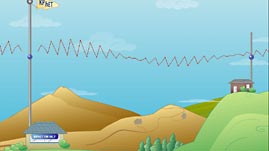Teachers' Domain - Digital Media for the Classroom and Professional Development
User: Preview

Source: PhET, Physics Education Techonolgy, University of Colorado
In this interactive simulation adapted from the University of Colorado's Physics Education Technology project, explore how radio waves travel from a radio transmitter to a receiver. Vary the frequency and amplitude of the oscillating charge in the transmitter to observe the relationship between the electromagnetic field and electron position. Investigate different ways to graphically represent the electromagnetic field by clicking the different types of field displays.
The entire electromagnetic spectrum is composed of electromagnetic radiation with a wide range of energies and wavelengths: radio waves, microwaves, infrared light, visible light, ultraviolet light, x-rays, and gamma rays. Radio frequency (RF) is a term given to the portion of the electromagnetic spectrum with long wavelengths and low frequencies. This includes radio waves and microwaves ranging from a few hertz (Hz)—a measurement of frequency in cycles per second—to about 300 billion hertz (or 300 gigahertz [GHz]).
RF radiation is used in many everyday devices, such as cellular telephones, cordless telephones, computers with wireless Internet access, baby monitors, and garage door openers. All of these devices operate similarly to the way a radio broadcast works. For example, a cordless telephone uses a base and a cordless handset, each of which functions both as a radio broadcast tower and a receiver. Both the base and the handset have an antenna that can transmit and receive. For an incoming call, the base receives a signal from the phone wire and converts it into a radio signal. It transmits this signal through its antenna to the handset antenna. When you speak, the handset antenna transmits a second radio signal at a different frequency for the base antenna to receive.
A radio transmitter works by oscillating electric charge up and down the broadcast antenna. When an alternating current is applied to an antenna, the movement of charged particles produces magnetic and electric fields. Depending on the frequency of the oscillation, different frequencies of electromagnetic radiation are created.
While sometimes discussed separately, electricity and magnetism can be viewed as simply two components of a single force—the electromagnetic force. A magnetic field is created as a result of a changing electric field. Similarly, an electric field is created as a result of a changing magnetic field. The moving charge in an antenna generates electric and magnetic fields that change direction with each oscillation. These fluctuating fields produce a self-propagating electromagnetic wave that travels through space as the fields repeatedly create one another.
When an electromagnetic wave from a radio transmitter encounters a receiving antenna, charged particles within the receiving antenna begin to move up and down in response to the fluctuating electric field. This allows the antenna to detect the passing radio wave and gather the information that the wave is transmitting. One type of information that is often transmitted by an electromagnetic wave is sound information, which radio stations produce by modifying the broadcast signal using techniques such as amplitude modulation (AM) and frequency modulation (FM).
Note: The strength of an electromagnetic field is greatest at its point of origin and decreases with distance from the source. At any given place, the field is described by a vector quantity—it has both magnitude and direction. In this simulation, arrows represent the vector quantities.
 Loading Standards
Loading Standards Teachers' Domain is proud to be a Pathways portal to the National Science Digital Library.
Teachers' Domain is proud to be a Pathways portal to the National Science Digital Library.
